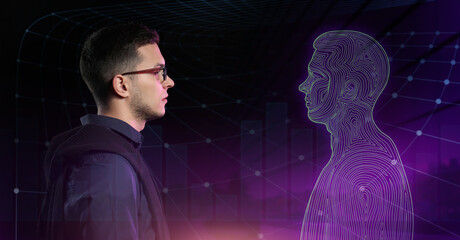Digital Twin: the key to the industry 4.0
- hugochambon1
- Apr 29, 2024
- 4 min read
In the modern industrial landscape, the concept of the digital twin is emerging as a revolutionary innovation, offering professionals a powerful tool for improving their production processes. But what exactly is a digital twin?

Definition of a digital twin
A digital twin is a virtual replica of a real object, process or system. It is an accurate, real-time digital representation fed by data from sensors and other sources. This virtual replica enables professionals to efficiently analyse, simulate and optimise their industrial activity.
Types of digital twin
There are several types of digital twin, each adapted to specific applications in various industrial sectors. Here are the main types:
Digital product twin : this type of twin represents a virtual replica of a physical product. It enables engineers to visualise, test and optimise the operation and performance of the product before it is physically manufactured. For example, in the automotive industry, a digital twin of a car can be used to simulate its behaviour on the road and carry out safety tests. With a digital twin, engineers can create a virtual version of the factory, integrating all the equipment, manufacturing processes and even material flows. This digital representation allows teams to test different plant configurations, optimise production flows and anticipate potential problems, all before physical construction begins.
Digital process twin: this type of twin represents an industrial process or production line in its entirety. It can be used to analyse and optimise workflows, identify bottlenecks and simulate different scenarios to improve operational efficiency. For example, in the manufacturing industry, a digital factory twin can be used to test different production configurations to maximise output.
Digital system twin: this type of twin represents a complex system made up of several interconnected components. It is used to model and simulate the overall operation of the system, identifying the interactions between the various elements and optimising their collective performance. For example, in the energy sector, a digital twin for an electricity network can be used to forecast and manage electricity demand in real time.
Digital city twin: this type of twin represents a city or region as a whole, integrating geospatial, environmental, demographic and socio-economic data. It enables urban planners and political decision-makers to simulate and plan urban development, optimise infrastructures and public services, and forecast the impact of climate and demographic change.
The importance and deployment of digital twins
The use of digital twins presents crucial challenges for various sectors.
Automotive: optimisation of manufacturing processes and simulation of new models.
Manufacturing: real-time production monitoring, workflow optimisation.
Construction: project planning, supply chain management and site safety.
Logistics: shipment tracking, stock management and route optimisation.
Medicine: patient modelling for surgical planning and simulation of medical procedures.
Health and safety: risk analysis, employee training and emergency simulation
The benefits of digital twin
Generally speaking, the use of digital twins in industry helps to optimise production processes, improve product quality and reduce downtime.
1. Better project lifecycle management
Digital twins provide complete support for all stages in the lifecycle of a product or system, from design and development through to operation and maintenance. They are used to validate the design, carry out tests, provide training and even for the decommissioning phase.
2. Collaborative environment
Digital twins simplify collaboration between the various parties involved, such as engineers, operators and maintenance personnel. They provide a common platform for data sharing, analysis and collective decision-making.
3. Cost reduction
Integrating virtual reality at the earliest stages of a design project is essential to avoid costly prototyping errors. By enabling teams to visualise and test products and processes virtually, virtual reality enables problems to be identified and corrected as soon as they occur, thereby reducing risks and unnecessary expenditure.
In industrial design, the digital twin enables precise visualisation of products, making it easier to identify potential improvements. In design and process review, it enables errors to be detected and adjustments to be made before the product goes into production, reducing costs and lead times.
4. Improving industrial processes
The digital twin plays an essential role in the virtual commissioning process by enabling the creation of an accurate virtual replica of industrial equipment and systems. This virtual representation makes it easier to simulate and test production processes before they are actually commissioned, reducing the risks and costs associated with implementation.
XR Twin: the industrial review tool accessible to all
The XR Twin software developed by LS GROUP opens up new horizons in the creation of digital twins. It takes its name from the English expression "digital twin". Accessible to all and easy to use, this software enables anyone to create immersive review scenarios without requiring advanced technical skills. This accessibility democratises the use of digital twins and facilitates their integration into industrial processes.
In conclusion, digital twins are an essential tool for the industry of the future. They can be used to improve operational efficiency, reduce production costs and optimise product quality. By integrating virtual reality right from the start of the design process, professionals can anticipate challenges and remain competitive in an ever-changing market.